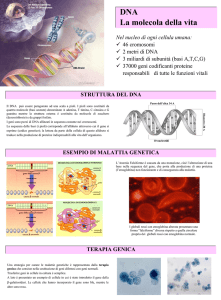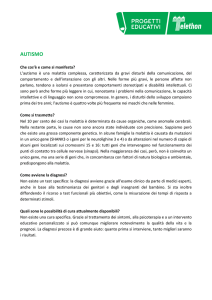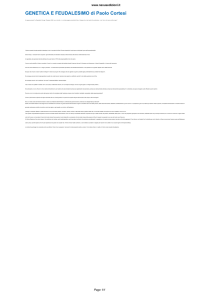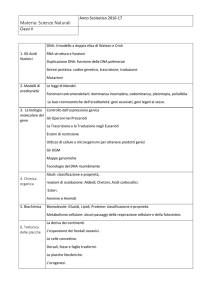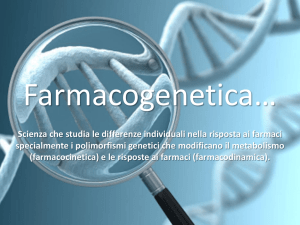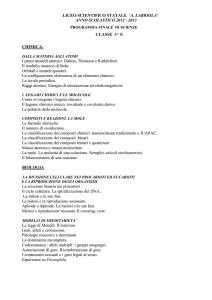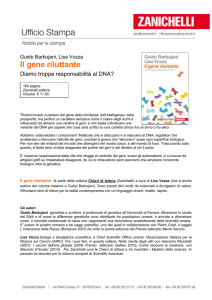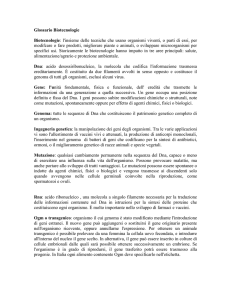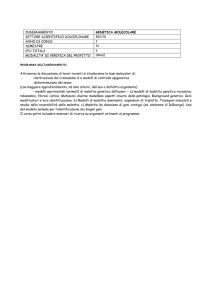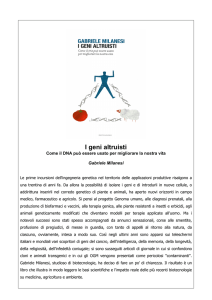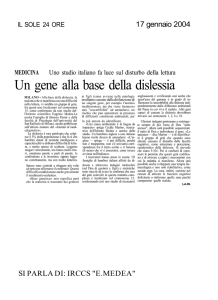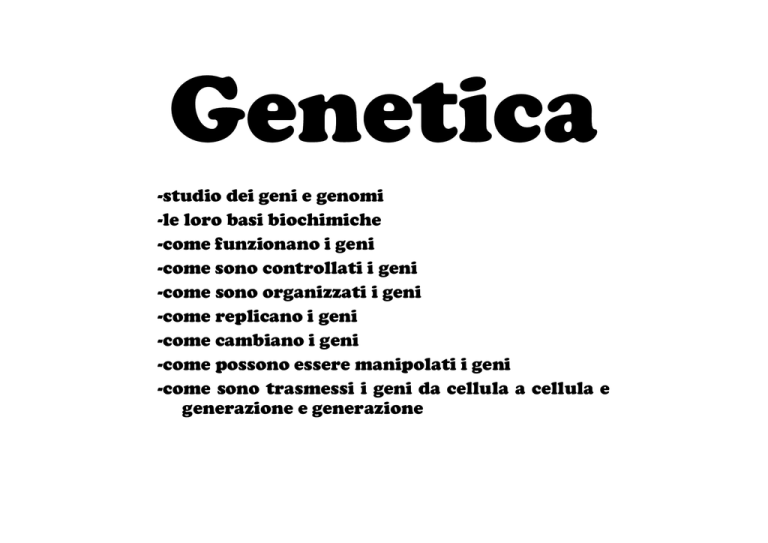
Genetica
-studio dei geni e genomi
-le loro basi biochimiche
-come funzionano i geni
-come sono controllati i geni
-come sono organizzati i geni
-come replicano i geni
-come cambiano i geni
-come possono essere manipolati i geni
-come sono trasmessi i geni da cellula a cellula e
generazione e generazione
Genetics Timeline
1866
Gregor Mendel published the
results of his investigations of
the inheritance of "factors" in
pea plants.
1933
Thomas Hunt Morgan won the
Nobel Prize in Physiology or
Medicine for his chromosome
theory of heredity: the genes
are on the chromosomes
1950's
Maurice Wilkins (1916- ), Rosalind
Franklin (1920-1957), Francis H. C.
Crick (1916- ) of Britain and James
D. Watson (1928- ) of the U.S.
discover chemical structure of
DNA, starting a new branch of
science--molecular biology.
1953
Watson and Crick made a
model of the DNA
molecule and proved that
genes determine heredity
1957
Arthur Kornberg produced
DNA in a test tube
1963
F. Sanger developed
sequencing procedure for
DNA
1966
The Genetic code was discovered;
scientists are now able to predict
characteristics by studying DNA.
This leads to genetic engineering,
genetic counseling.
1972
Paul Berg produced the first
recombinant DNA molecule
1973
Stanley Cohen and Herb Boyer
developed gene cloning, igniting the
biotechnology revolution.
1983
Barbara McClintock was
awarded the Nobel Prize for her
discovery that genes are able to
change position on
chromosomes
1985
Dr. Kary Mullis
discovered the PCR
procedure, for which he
was awarded the Nobel
prize.
1990
Gene therapy was
used on patients for
the first time
1994
The FDA approved the first
genetically engineered food
“FlavrSavr” tomatoes
engineered for better
flavor and shelf life, more
resistant to rotting by adding
an antisense gene which with
the production of the enzyme
polygalacturonase
1998
Mais MON810 is a OGM
maize made by Monsanto
that has been genetically
modified to produce an
insect toxin (called Bt)
1995-2000
'Bubble boys' saved
by gene therapy
1995
DNA testing in forensics
cases gains fame in the O.J.
Simpson trial
1997
Dolly the Sheep - the first
adult animal clone from an
adult somatic cell, using the
process of nuclear transfer
At the age of five, Dolly
developed arthritis and
began to walk stiffly
2000
The Human Genome Project
(HGP)
J. Craig Ventor (Celera), along
with Francis Collins, jointly
announce the sequencing of the
entire human genome
I geni e l’ambiente
I nostri geni necessariamente devono interagire con l’ambiente in cui
viviamo
Questa interazione di tipo culturale, climatica, ambientale etc.
determina cio’ che siamo, come e quanto ci sviluppiamo
Anemia falciforme
-emoglobina patologica, detta HbS
-soggetti eterozigoti, i cosiddetti
portatori del tratto falcemico,
producono meno del 50% di HbS e
sono di solito asintomatici
La condizione di tratto falcemico,
svantaggiosa (crisi emolitiche), riduce la
mortalità degli individui infestati dal
Plasmodium falciparum, agente eziologico
della forma mortale di malaria.
-cuore e linfonodi
ingrossati
-affaticamento
-anemia
-crisi vaso-occlusive
-morte
Nelle aree più colpite dalla malaria, il gene per
l'emoglobina falcemica (HbS) è molto comune
La protezione contro la malattia cresce fino al
60 per cento all'età di dieci anni
Il Plasmodium passa parte del suo ciclo vitale
nei globuli rossi, ma non puo’ vivere nei globuli
rossi falciformi pieni di fibre
I geni e l’ambiente
Wilhem Johannsen nel 1911
GENOTIPO-> patrimonio genico
dell’organismo ereditato (praticamente
costante per tutta la vita)
FENOTIPO-> manifestazione fisica di un
organismo, determinato sia dal genotipo ma
anche da fattori ambientali che possono
avere una maggiore o minore influenza,
spesso tale da rendere imprevedibile il
fenotipo stesso pur conoscendo il genotipo
(puo’ cambiare di continuo durante la vita)
Norma di reazione del genotipo
es. di interazione genotipo/fenotipo
3 genotipi
stesso genotipo-> fenotipi
diversi

